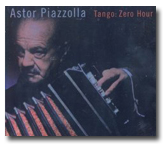Music |
Tango: Zero Hour
Astor Piazzolla
By
Published: Jan 01, 2006
Category:
Jazz
Tango: Zero Hour
Astor Piazzolla
Twenty years ago a friend gave me tickets to see Astor Piazzolla and his Quintet. All she said was: "He’s very, very good." Which is to say: I
went without knowing a thing about him.
For that matter, I didn’t know much about most non-mainstream musicians. I was a young man from the Michigan countryside newly minted as a graduate student in Cambridge, Massachusetts. In the past two decades, I have reduced my ignorance considerably. But no matter what I learn, Piazzolla remains without compare in terms of musical creativity and raw emotion.
The inside cover of Astor Piazzolla’s 1986 CD "Tango: Zero Hour" declares: Tango + Tragedy + Comedy + Kilombo (Whorehouse) = New Tango. That declaration is certainly audacious, provocative, politically questionable. Like graffiti posted on a dance hall door, Piazzolla invites a listen while warning of danger. Watch out: seduction lies ahead.
Piazzolla’s nightly dance partner was a bandoneon, an accordion-like instrument originating in Germany in the 19th century. The instrument is notoriously difficult to hold properly, let alone master. Piazzolla’s bandoneon sounds like a bass accordion whose individual reeds draw out sound with tremulous nuance. Piazzolla’s playing, and that of his Quintet, is nothing short of lovemaking by dim candlelight, with the ease and timelessness of later life, celebrating soulful passion well beyond physical beauty.
Piazzolla was born in 1921 in the small sea-side town of Mar del Plata, 250 miles south of Buenos Aires. He studied in Buenos Aires, New York and Paris before beginning his performance career playing with upper tier Tango bands in Buenos Aires. He quickly went on to form his own bands of five to nine or more musicians. He mastered Tango, classical, and jazz composition and is credited (and blamed) for creating the Nuevo Tango.
His New Tango transformed traditional Tango from a predominantly dance form to a vehicle better experienced in concert and jazz venues. (Piazzolla even changed the physical properties of performance by standing while playing rather than sitting as custom decreed.) In Argentina, these changes were nothing short of heretical. Fist fights broke out at his concerts. Think Bob Dylan plugging in an electric guitar at the Newport Folk Festival or touring Europe with The Band in the mid ’60s.
"Zero Hour" features the quintet — Pablo Ziegler (piano), Fernando Suarez Paz (violin), Horacio Malvicino Sr. (guitar), and Hector Console (contrabass) — that appeared with Piazzolla on many of his one hundred recordings. While Piazzolla’s bandoneon is the heart and lungs of each piece, every note of the violin, guitar, piano and bass parts is central to the whole. What is most apparent in the interplay of the musicians is their trust in timing and cadence; this only comes when musical equals have performed together for thousands of hours over many years.
Shortly after "Zero Hour" was released, Piazzolla said that he believed it was his best — "we gave our souls to make it." Hyperbole aside, you can almost hear that. On the second cut, Milongo del Angel, the drama of sensuous love is played out in notes, rhythms, and pauses. The sounds are drawn out, change cadence, and add nuance as time slows down, soars and then returns to earth only after nearly unbearable tension. Concierto para Quinteto disturbs and then marches with joy. In Contrabajissimo we first hear a low, buzzing bass, then guitar and violin and only later an unrelenting bandoneon. A full life is told in this 10 minute piece. Finally, in Mumuki, each instrument takes a dramatic turn in passages that slow to a stand-still, then accelerate, and finally culminate in a final, single, drawn-out note that slides off the table into oblivion and sleep.
The language of sexuality is the first and best metaphor for this music. Piazzolla captures passionate feeling in all its range including love, loss, anger, tenderness, regret and splendor in the caress of his bandoneon. Think the romance of Sinatra, the sin in Jim Morrison’s voice, the heat and sweat of an Argentinean night in a room too small. Inebriation without drunkenness. Musical notes held to the breaking point. Disequilibrium. And always return. Return to quiet, to stasis, to earth.
If you know Piazzolla already, calling attention to the existence of his music is trite. I apologize. It is like suggesting Bela Fleck, Tony Rice, Carlos Santana, Miles, Monk or Bill Evans are worth a listen. Ah, but for those who do not yet know him, pleasure awaits in a language that arrives from a dream state. The language is passion, it is grief, and it is for mature listeners only.
Piazzolla’s human form left us in July 1992 after a prolonged illness but "Tango: Zero Hour" — and many of his other CDs — allow us to expand what we know about life, risk, love, and loss.
Zero Hour. Midnight. The dividing hour. Life won’t be the same.
— Michael P. Krupa, Guest Butler, is a psychologist and health care consultant, husband, and father whose interests include all things musical, poetry, and photography. He lives in Concord, Massachusetts.
To buy "Tango: Zero Hour" from Amazon.com, click here.


